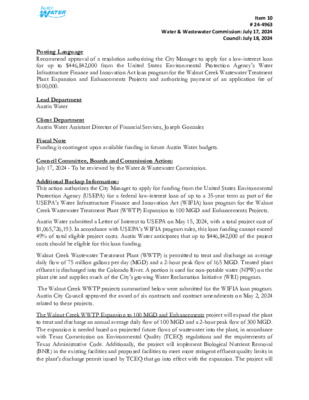Item 10 — original pdf
Backup

Item 10 # 24-4963 Water & Wastewater Commission: July 17, 2024 Council: July 18, 2024 Posting Language Recommend approval of a resolution authorizing the City Manager to apply for a low-interest loan for up to $446,842,000 from the United States Environmental Protection Agency’s Water Infrastructure Finance and Innovation Act loan program for the Walnut Creek Wastewater Treatment Plant Expansion and Enhancements Projects and authorizing payment of an application fee of $100,000. Lead Department Austin Water Client Department Austin Water Assistant Director of Financial Services, Joseph Gonzales Fiscal Note Funding is contingent upon available funding in future Austin Water budgets. Council Committee, Boards and Commission Action: July 17, 2024 - To be reviewed by the Water & Wastewater Commission. Additional Backup Information: This action authorizes the City Manager to apply for funding from the United States Environmental Protection Agency (USEPA) for a federal low-interest loan of up to a 35-year term as part of the USEPA’s Water Infrastructure Finance and Innovation Act (WIFIA) loan program for the Walnut Creek Wastewater Treatment Plant (WWTP) Expansion to 100 MGD and Enhancements Projects. Austin Water submitted a Letter of Interest to USEPA on May 15, 2024, with a total project cost of $1,065,726,193. In accordance with USEPA’s WIFIA program rules, this loan funding cannot exceed 49% of total eligible project costs. Austin Water anticipates that up to $446,842,000 of the project costs should be eligible for this loan funding. Walnut Creek Wastewater Treatment Plant (WWTP) is permitted to treat and discharge an average daily flow of 75 million gallons per day (MGD) and a 2-hour peak flow of 165 MGD. Treated plant effluent is discharged into the Colorado River. A portion is used for non-potable water (NPW) on the plant site and supplies much of the City’s growing Water Reclamation Initiative (WRI) program. The Walnut Creek WWTP projects summarized below were submitted for the WIFIA loan program. Austin City Council approved the award of six contracts and contract amendments on May 2, 2024 related to these projects. The Walnut Creek WWTP Expansion to 100 MGD and Enhancements project will expand the plant to treat and discharge an annual average daily flow of 100 MGD and a 2-hour peak flow of 300 MGD. The expansion is needed based on projected future flows of wastewater into the plant, in accordance with Texas Commission on Environmental Quality (TCEQ) regulations and the requirements of Texas Administrative Code. Additionally, the project will implement Biological Nutrient Removal (BNR) in the existing facilities and proposed facilities to meet more stringent effluent quality limits in the plant’s discharge permit issued by TCEQ that go into effect with the expansion. The project will Item 10 # 24-4963 Water & Wastewater Commission: July 17, 2024 Council: July 18, 2024 also convert the disinfection method from chlorine gas to ultraviolet (UV) disinfection. The project includes several distinct components: a new 25 MGD treatment train with BNR and UV, upgrade of the existing treatment to BNR and UV, new peak flow treatment, new influent siphons, new effluent pipe and outfall, and a flood wall around the site. The Walnut Creek WWTP Influent Lift Station project will replace the existing influent lift station and receive the increased flows from the Johnny Morris Wastewater Interceptor and pump the flow to Walnut Creek WWTP headworks. The Walnut Creek WWTP Headworks #1 Improvements project will rehabilitate and make improvements to the existing Headworks #1 including screening and grit removal, as well as mechanical, electrical, HVAC, odor control, and structural improvements. The Walnut Creek Primary Clarifier and Flow Equalization Basin Rehabilitation project will rehabilitate the existing Primary Treatment Complex (PTC) #1 and #2, including clarifier mechanism replacements, electrical, HVAC, odor control, and structural improvements. The Crosstown Tunnel Centralized Odor Control Facility project will construct a new odor and corrosion control facility at the junction box upstream of the plant, where the Crosstown Tunnel and Walnut Interceptor converge, to provide odor and corrosion.